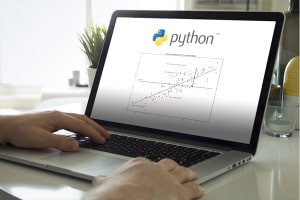This course covers each step you should take when solving business problems using linear regression in Python and the important measures adopted before and after doing so. You must have the correct data before running the analysis and be able to judge the efficacy of the model afterwards. This course gives you the ability to interpret the results in a way that helps your business. ‘Qualitative’ data refers to a variable that cannot assume a numeric value but can be classified into two or more non-numeric categories, in contrast to ‘quantitative’ data. We discuss the essential libraries used in Python and the different types of string functions involved.
We begin with the concept of ‘parenthesis’, which should be used with multiple arithmetic operators in Python. Then we move on to ‘tuples’, which are similar to lists but can’t be modified and are often classified as ‘immutable’. We explain ‘NumPy’ packages and how they provide high-performance vectors, matrix and higher-dimensional data structures for Python before unpacking ‘descriptive statistics’, which refer to the methods used to organise, display and describe data through tables, summary measures and graphs. Then follows analysis of ‘inferential statistics’, which consist of methods that use sample results to help make decisions or predictions about a population. We discuss the different types of plot functions in Seaborn and demonstrate the use of Python’s descriptive statistics tools.
This course offers insight into machine learning, which optimizes performance by automatically detecting patterns in data to predict future outcomes. We explain how to interpret distribution curves and graphs and we explore data analysis, linear methods, linear regression, and multiple linear regression. This course can help business managers, executives or anyone interested in learning how Python’s linear regression can be used to predict how data will behave and take advantage of those changes. Sign up to become a linear regression and problem-solving expert to boost your career and ability to invest.
What You Will Learn In This Free Course
View All Learning Outcomes View Less All Alison courses are free to enrol, study, and complete. To successfully complete this Certificate course and become an Alison Graduate, you need to achieve 80% or higher in each course assessment.
Once you have completed this Certificate course, you have the option to acquire an official Certificate, which is a great way to share your achievement with the world.
Your Alison certificate is:
- Ideal for sharing with potential employers.
- Great for your CV, professional social media profiles, and job applications.
- An indication of your commitment to continuously learn, upskill, and achieve high results.
- An incentive for you to continue empowering yourself through lifelong learning.
Alison offers 2 types of Certificate for completed Certificate courses:
- Digital Certificate: a downloadable Certificate in PDF format immediately available to you when you complete your purchase.
- Physical Certificate: a physical version of your officially branded and security-marked Certificate
All Certificate are available to purchase through the Alison Shop. For more information on purchasing Alison Certificate, please visit our FAQs. If you decide not to purchase your Alison Certificate, you can still demonstrate your achievement by sharing your Learner Record or Learner Achievement Verification, both of which are accessible from your Account Settings.











 Avg. Hours
Avg. Hours  Contains Video
Contains Video  CPD Accredited
CPD Accredited 
 Total XP:
Total XP: 
 Knowledge & Skills You Will Learn
Knowledge & Skills You Will Learn 







